Flashpoint: South China Sea Review | Tension in Southeast Asia
Flashpoint: South China Sea is an intriguing tabletop game with a heavy dose of geopolitics.
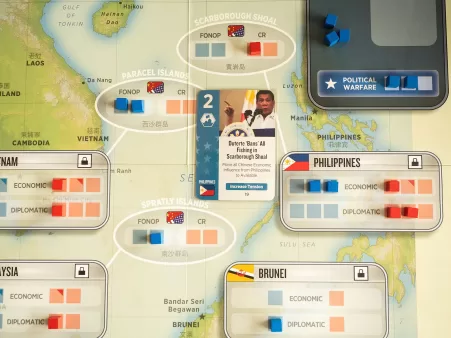
Flashpoint: South China Sea by GMT Games brings this geopolitical tug-o-war between global powers China and the USA to a 2 player card driven and area control system that promises to be accessible to both newbies and veteran boardgamers alike in a playtime of 30-45 minutes. Does the game achieve these lofty goals? Lets find out…
Introduction
The West Philippine Sea, or as it is most commonly known outside the Philippines – the South China Sea, has seen much news in recent months. With a whopping USD 5.3 trillion worth of goods transiting annually, rich fishing grounds, strategic islands and rumors of vast oil fields; it is arguably the maritime region with the highest geopolitical tension in recent years.
What’s in the Box?
The game comes in a half size bookshelf box typical of GMT. Inside, one will find a gorgeous 22″x17″ mounted game board depicting the geographical area of the South China Sea, disputed islands, and South East Asian nations bordering the region. The standard game of Flashpoint is a two player affair that includes the following components: 48 Event Cards, 7 Scoring Cards, 16 red cubes, 16 blue cubes, 3 wooden discs, a 2 player rulebook, a playbook, and 2 player aids. The game also comes with a solo mode which includes these additional components: a solo rules of play, a solo player aid and 8 solo cards.
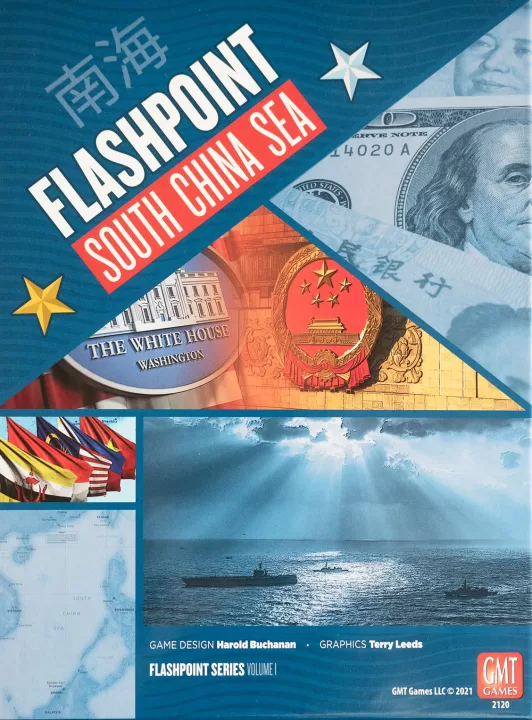
box art
As mentioned above the board is gorgeous, using muted colors and a minimalist design to bring out important game elements without looking too busy and cluttered. The cards are thick but lack the typical linen finish often found in other GMT titles but are nontheless printed well with clear text and images. The wooden bits are typical GMT fair and contain a few extra pieces just in case players misplace components. It is interesting that they included a standard rulebook and a solo rulebook for the game. The rules are fairly short but having two separate rulebooks makes learning and referencing rules during play even easier. The playbook is excellent as it features sample plays, designer notes and a brief explanation of the events depicted in each Event Card. All in all, it is quality production, especially at its price point.
The New Cold War
In Flashpoint, the players take the role of China and the United States as they vie for control and influence over the South China Sea region. Although one may think this a wargame, especially with images of warships in the box cover, it is essentially a geopolitical game with no real armed conflict. As either China or the US, players use cards to affect diplomatic and economic impact on regional countries and initiate military operations to exert influence over disputed island chains, but never erupting into full blown war.
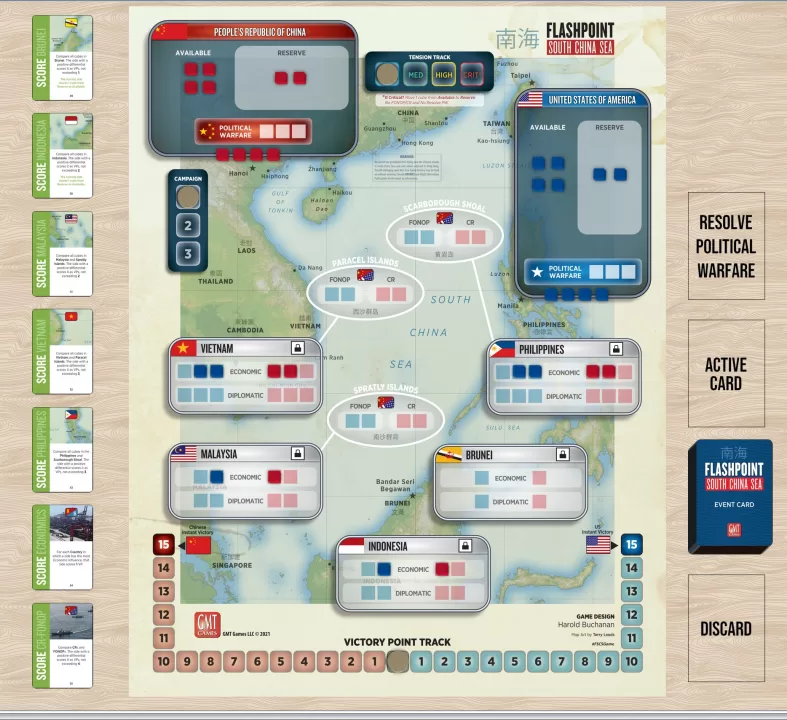
2 player setup
At the start of the game, Scoring Cards are laid out to the side of the board. Each of these cards correspond to a country, economic influence or islands influence (FONOP/CR). Throughout the game, players place cubes in diplomatic and economic spaces in countries and engage in Freedom of Navigation operations/FONOP (US); or Chinese Reclamation/CR(China) to exert control over disputed islands. Players then activate scoring cards (by playing scoring impact) and whoever has the most cubes for that scoring card gains points.
The game is played through 3 campaigns. At the start of each campaign, each player draws 6 Event Cards. On a player turn, he/she plays one of these cards. Each Event Card has an Event, an Operation Value, a Scoring Impact and a Mode match, each of which correspond to game actions. When a player plays a card, he will choose which of these actions he will play for said card.
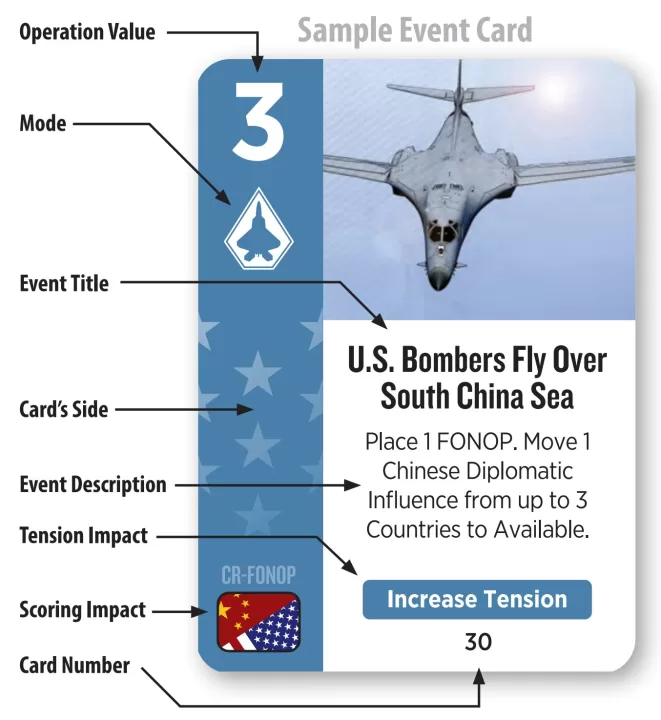
anatomy of an Event Card
If a card has the player’s color (blue for US, red for China), he/she is eligible to play the Event. The player resolves the text instructions of the event. Typically these events will allow the player to place cubes from his available pool (some cubes become unavailable/reserve thru game effects), and places them in game spaces as directed by the event card. Some event cards may also remove or replace opponent cubes.
A player may also play a card for Scoring Impact (especially if he/she has an advantage). The player then executes the instructions of the associated Scoring Card, and points are allotted to the winner. The scoring card is then flipped and is unavailable till the next campaign.
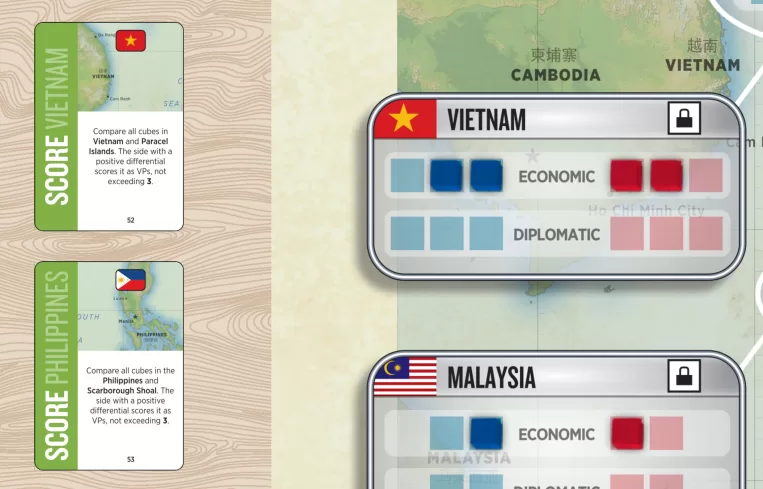
sample Scoring Cards
The player can use a card for its Operations Value. The Player Aid below lists available actions a player can take using Op points. He/She may execute any mix of operations up to the total value of the the Op Value on the card played. FONOP, CR and Political Warfare increase the tension track, and Chinese Reclamation costs more Op points as tension increases. As tension hits critical, certain Ops become unavailable; and can only be accessed once again as tension decreases.
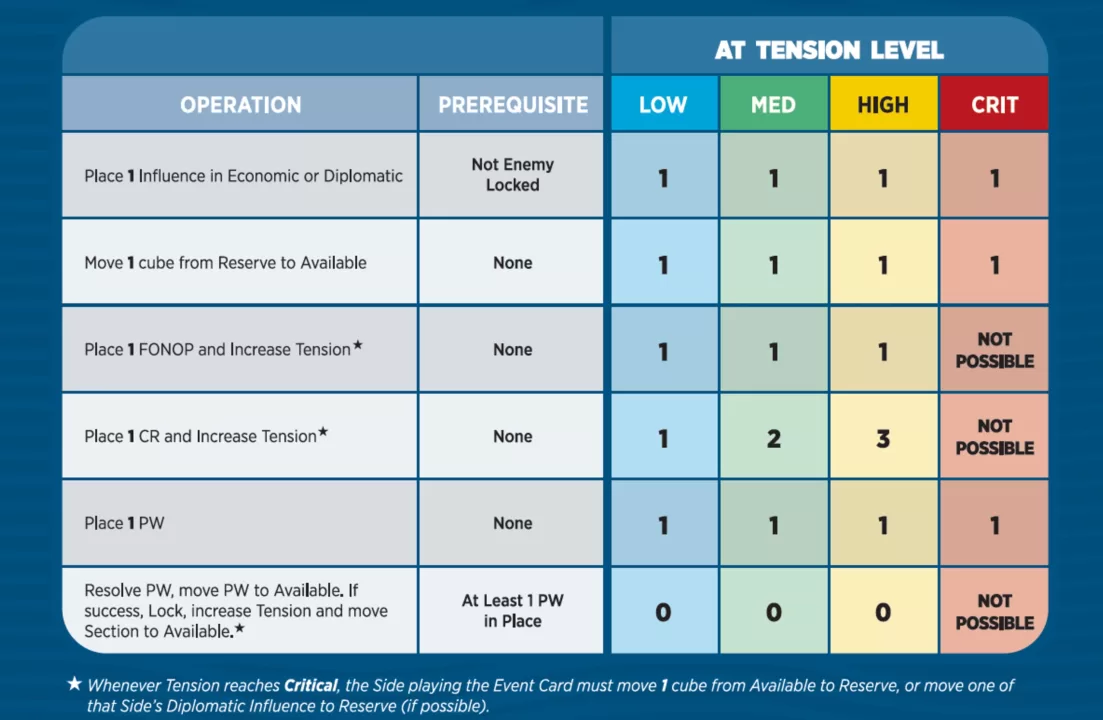
Operations and their associated costs
Lastly, a player can use an event card for a Mode Match. In this action, the player matches the mode symbol in the card played with that of the top card of the discard pile. If the mode icons are similar and the card on the discard pile has the same color as that of the active player, the active player can then play the event of the discard card or use its scoring impact.
Players continue playing cards till all are used and a new campaign begins. At the start of the second and third campaign, the tension track is lowered, all US FONOP cubes are removed from the islands(China’s CR cubes remains!), each side removes one economic cube from each country and all scoring cards are flipped up. Players draw six cards each again and play resumes as usual. During the end of the third campaign, all scoring cards are flipped face up and are scored one last time again. The player with the higher score by game end wins; but if a player reaches 15 points at any time during the game, game ends and he/she is the winner.
That in essence is a summary of the rules. Of course there is more minutiae, which one can check in the full online rulebook. Also, check out a full video playthrough of the game from Legendary Tactics
A Sleek Solo System
The game also comes with a Solo bot. The system uses a player aid and a set of 8 solo cards to determine the bot actions. The solo mode comes with its own rulebook which rehashes many of the game concepts from the two player game while adding the solo specific ruleset. The solo bot simulates human play and with the exception of one or two mechanics – plays by the same rules as would a human player. The solo bot turn is simple to implement; you just follow the bot’s sequence of play in the player aid and use the solo cards when directed. The solo bot is also a good player. Gamers new to Flashpoint will do well to play a solo game or two in order to learn some tactics the bot implements for a more optimized playstyle.
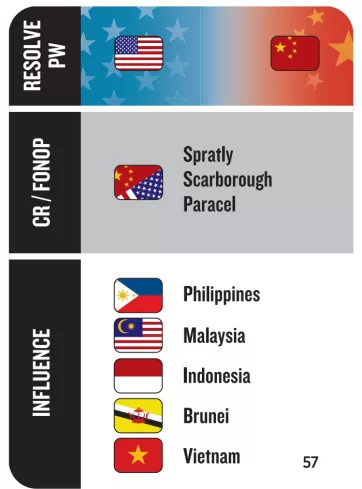
a sample solo card
A Knife Fight in a Phonebooth
At first glance, enthusiast boardgamers might think this game as Twilight Struggle Lite. It has a similar card driven game system, a (smaller) geopolitical map, a tension track. But it is mostly a new, refined system in my opinion. The most obvious difference is of course the scope and length of game. While Twilight Struggle is a global affair and can take 3 hours, Flashpoint is regional and takes around 30 minutes for a full game. The new card design and card system in Flashpoint also gives options to players and does not hem them into a corner – a common complaint of newer players to Twilight Struggle. As such, foreknowledge of event cards is not as essential in Flashpoint. Political Warfare in Flashpoint locks countries just as regions are locked (by DEFCON tension) in Twilight Struggle – but are much easier to ‘unlock’ by initiating a counter Political Warfare Op.
All these seemingly small changes transform the game to a more dynamic, and easier to play game as compared to the venerable Twilight Struggle. Thus players don’t really feel limited by a bad hand draw or an Op that completely locks him/her out of a region or action. There are always options, and its up to the player to optimize these choices to score efficiently. So as Twilight Struggle is a game that incorporates major elements of crisis management and area and action denial; Flashpoint is more dynamic and free flowing with players always having strategic options during their turn and its a matter of playing the card and action that benefits you the most with little to no consequence for playing said card.
Because of the brisk pace of play and limited regions of contention, the game really feels like a knife fight in a phonebooth. Players jab at areas and need to spread their resources and attention wisely to make the most of scoring opportunities – scoring opportunities that are also under their control, since players choose when to score. The scoring system in this game is zero sum. Both players share the same track and one’s gain is the other’s loss. This makes scoring tight and it is common to see point swings ingame. This zero sum tug-o-war leads to some interesting strategic choices. Does one shore up his influence in a country in the hopes of maximizing scoring potential, or are you better off spreading influence? Does one focus on a country’s economic influence but make you susceptible to political warfare? Do you, as the US player, maximize FONOP, knowing your cubes will all be gone at the start of the next campaign? It’s strategic decisions like this, framed in a fast playing system that makes Flashpoint: South China Sea a compelling play. I would liken its play style to a mix of Twilight Struggle Lite with a dash of Blitzkrieg – smooth, fast playing, with easy to understand game mechanics, with a system that provides strategic versatility and furious back and forth swings of scoring.
Some earlier reviews say the game is too uniform – that, aside from FONOP and CR, China and the USA play basically the same; and that diplomatic and economic tracks are basically the same. I slightly disagree with this view. The asymmetry of play comes from the different Event Cards and what they represent in real life geopolitics. And as an Asian who is quite up to date with current events, I can see why those events have those particular game effects. Someone unfamiliar with regional politics may find those same Event Cards quite opaque though. I also find differences in the diplomatic and economic track as one track scores, while the other has Event Cards that rely on diplomatic cubes to be activated. However, I see how some might think them similar as they, in fact, look physically identical on the game board. I do agree though, that additional cards and card effects and a few more in game systems would have made playing China and the USA more distinct, but this could also increase complexity and playtime, which was not the intent of this system.
Asian Crisis or Asian Opportunity
Harold Buchanan, the game designer, makes an interesting assumption in his designer notes – both superpowers, China and the USA, will exert influence and make military posturing in the South China Sea but will never go into a full blown war because everybody loses when such occurs. It is a political analysis that permeates throughout the game; as tension becomes critical, military operations and provocative political actions cease, and tension inevitably ebbs. It is an interesting premise that lends to further discussion outside of the game.
The game was printed in 2022 and many of the card events represent current events from 2016 to 2021. It is, in essence, a time capsule on the state of regional affairs for that time period. Thus the game can be an effective educational tool for South East Asian political affairs of the late 2010’s and can provide students with deeper insights on geopolitical maneuverings in the ASEAN.
Design wise I think this game has many interesting elements, many of which were already discussed. A feature of the game I haven’t mentioned yet is that players bid for advantage. The game design and playtests has China as the slightly stronger side (likely by virtue of its CR not removed after a campaign). So the game is inherently “imbalanced”. But players bid to play China and the US player gets VP’s depending on the bid of the China player. Just like his political assumptions, the bidding mechanism is an interesting mechanic because it postulates that the players self correct the imbalance themselves. In his design notes, the designer states that “balance” depends most on the players themselves rather than the game system; and what may be balanced for two experienced players may be totally imbalanced for players of different skill levels and experience.
Aside from the bid for advantage bidding system, most mechanics in this game can be found in other games. But the strength of this game does not rely on new or innovative mechanics, but in new and efficient ways of implementing tried and true systems to come out with a sleek, fast playing game on a complex subject. In that aspect, I believe Flashpoint does a great job. It is perfect for a 30-45 minute strategic jaunt. Although there were times when I wished it offered more. More cards, more asymmetry, a bigger map with more regions to fight over, more systems, longer game play to build more assets, etc. But I do understand this was not the intent of the game. The designers want to keep the “complexity budget” accessible and fast playing. The good news is that the game seems to have a modular design; it seems to be built with the intent of additional cards and systems in some future iteration. I do hope Mr. Buchanan and Co. build on the design and I am hoping to see expansions of Flashpoint: South China Sea in the future.
So who is this game’s audience? It is definitely not a grand strategy game in the like of Twilight Struggle or Here I Stand. It does not present with novel mechanics nor engine building so it may not appeal to some eurogamers. But it is still a very solid design despite. A highly strategic offering on complex real world current events wrapped in a sleek and fast playing system is a triumph in itself.
If you’ve wanted to try Twilight Struggle-like games but were too intimidated or didn’t want to play for three hours, check out this game. If you are interested in ASEAN and South China Sea geopolitics, check out this game. If you want a tight two player game where competitive tension is brought about by player interaction and not rules overhead, check out this game. If you want a solo game with a bot that can offer you a run for your money- and even teach you gameplay tips, check out this game. If you are a wargamer and want a shorter game that you can play during lunch or a game portable enough to bring on a trip to the beach, check out this game. If you are any of those, I don’t think you’ll be disappointed.
Final Verdict: 8.5/10
Related:

